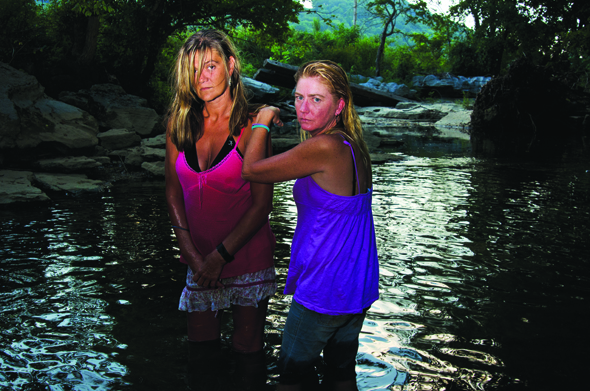Sign up for the daily CJR newsletter.

Sweet relief Women cool off in a creek in Dowelltown, TN. (Stacy Kranitz)
Catch Stacy Kranitz on a summer night and there’s a good chance she’s sleeping in her car somewhere in the mountains of Appalachia. Kranitz has spent the past three summers crisscrossing the region with little more than a DSLR camera, taking intensely personal portraits of its people and their daily lives.
Kranitz funds her summers with student loans (she’s a graduate student at the University of California, Irvine) and occasional freelance work for magazines like Mother Jones, Wired, and Rolling Stone. But her passion, and the reason she’s in Appalachia, is her own project–an open-ended, expansive examination of rural life and all the accompanying ugliness, violence, and beauty.
There’s a history of outsiders documenting Appalachia and applying their moral judgment to the people and lives represented in their work. January will mark 50 years since Lyndon B. Johnson declared the War on Poverty, spurring photojournalists like John Dominis, shooting for Life, to descend on the region, producing searing images of Appalachian life intended to shock the nation into action. It was a well-intentioned effort, but much of the work reduced Appalachians to stereotypes of poverty.
Kranitz spent part of her childhood on the periphery of Appalachia, in Kentucky and Tennessee, but she’s still an outsider and she knows it. She also knows that it would be easy for her work to perpetuate the same stereotypes that were reinforced by photojournalists 50 years ago. She tries to avoid defining her subjects by their circumstances in the only way she can, with ardent self-criticism. She also avoids the temptation to draw objective conclusions from her work.
“If I actually came up with a result or a thesis, I’d ruin the project,” she says in a phone interview from a rest stop in New Mexico, taking a break from her drive back to school in California. “Taking on representation in Appalachia–when I say it out loud it sounds like a joke.”
Because she does most of her work independently, Kranitz says she worries less about the standard ethical concerns of photographers on assignment. She’s able to be less formal in her relationships with her subjects, and she doesn’t try to separate her public and private lives. She can do drugs if she wants, sleep with people if she wants, and stay in her subjects’ homes. Since she’s right there taking part, she’s able to capture scenes that can appear sordid.
From men stripping off their shirts on train tracks to women washing each other’s feet, her photographs reveal a personal, sometimes sexual energy between photographer and subject. Kranitz says traveling and working alone as a woman means she is inevitably sexualized, and she uses her camera to turn the sexualization back on her subjects.
Kranitz is out of Appalachia now, done shooting until next summer. She’s in her last year of school and is using the photographs she made in Appalachia for her master’s thesis. But she says the project is nowhere near complete. “In 10 years I’m going to need another 10 years,” she says. “The job is to start a dialogue.”
Has America ever needed a media defender more than now? Help us by joining CJR today.






